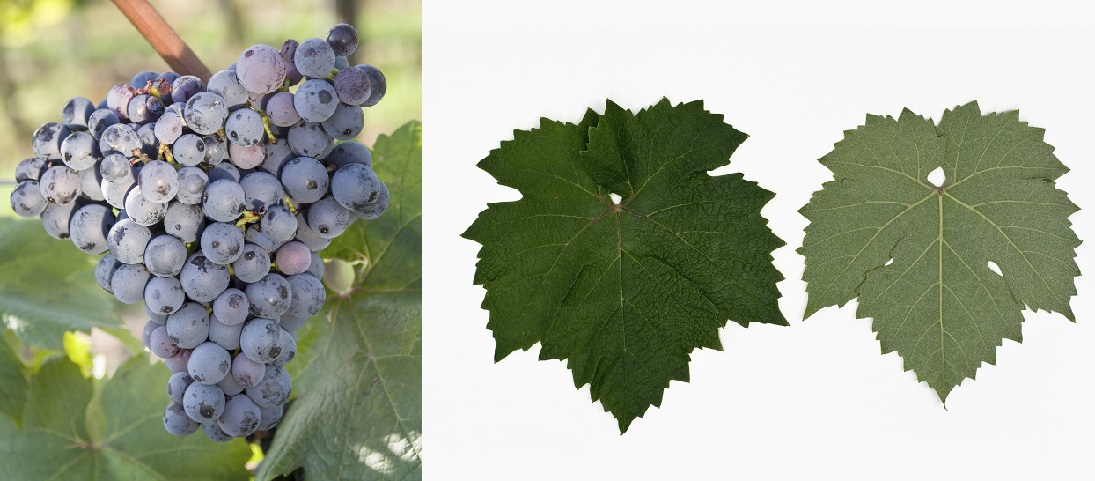The red grape variety originates from Spain. Around 80 synonyms attest to the vine's great age and wide distribution. Some alphabetically grouped by country are Graciana (Argentina); Xeres (Australia); Charge Mulet, Courouillade, Couthurier, Morastell, Morrastell, Négrette de Montauban, Négrette de Pays, Perpignanou Bois Dur, Plant de Ledenon, Tannat Bordelais, Tannat Gris (France); Bastardo Nero, Bovale, Bovaledda, Bovaleddo, Bovaleddu, Bovaleddu Bianca, Bovale Piccolo, Bovale Piticco, Bovale Sardo, Bovali, Bualeddu, Cadelanisca, Cagliunari, Cagnolari Nero, Cagniulari, Cagnovali, Cagnovali Nero, Caglunari, Cagnulari Bastardo, Cagnulari Sardo, Cagnulatu, Caldareddhu, Calda Reio, Uva Cagnelata (Italy); Minostello, Minustello, Minustellu, Minustillu (Corsica); Tinta Miúda (Portugal); Alicante, Carrixa, Casca, Cendron, Graciano 15-5, Graciano de Haro, Graciano Tinto, Monastel, Monastrell Menudo, Monastrell Verdadero, Moristell, Muristellu, Tinta, Tinta de Fontes, Tinta do Padre Antonio, Tinta Fontes, Tinta Mencida, Tinta Menuda, Tintilho, Tintilla, Tintilla de Rota, Tintillo, Zinzillosa (Spain).

It must not be confused with the varieties Bobal, Mazuelo (Bovale, Zinzillosa), Monastrell (Mourvèdre), Moristel, Morrastel Bouschet, Négrette, Parraleta or Pascale, despite seemingly suggestive synonyms or morphological similarities. The parentage (parentage) is unknown, but some genetic relationships have been elucidated by DNA analysis. The variety is a parent of the presumably natural crosses Mandón, Négret Castrais and Tinta Martins. The varieties Bovale Sardo and Cagnulari (many similar synonyms) cultivated in Sardinia are identical. The medium-late ripening, low-yielding vine is susceptible to downy mildew and grape rot. It yields colourful, tannin- and extract-rich red wines with incisive acidity and aromas of pepper and cherries as well as ageing potential.
The variety was widespread in Spain in the 19th century until phylloxera, but then faced extinction and was revived on the occasion of the upward classification of the Rioja area to DOCa. Today, it again occupies 2,080 hectares of vineyards. In France, it used to be popular under Morrastel in Languedoc-Roussillon until the middle of the 19th century, but today there are only 10 hectares. It arrived in Sardinia during the Spanish occupation in the 16th century (not vice versa). Here it is permitted under Bovale Sardo or Cagnulari in the DOC wines Alghero, Campidano di Terralba and Mandrolisai on 437 hectares. In Portugal, it occupies 326 hectares as Tinta Miúda, mainly in the Alentejo and Lisboa areas. Other populations exist in Argentina (18 ha), Australia (31 ha), Chile (1 ha) in California and South Africa (8 ha). In 2016, a total of 2,910 hectares of vines were designated. It is thus ranked 146th in the world grape variety ranking (Kym Anderson).
Source: Wine Grapes / J. Robinson, J. Harding, J. Vouillamoz / Penguin Books Ltd. 2012.
Images: Ursula Brühl, Doris Schneider, Julius Kühn-Institut (JKI)
Voices of our members

For my many years of work as an editor with a wine and culinary focus, I always like to inform myself about special questions at Wine lexicon. Spontaneous reading and following links often leads to exciting discoveries in the wide world of wine.
Dr. Christa Hanten
Fachjournalistin, Lektorin und Verkosterin, Wien